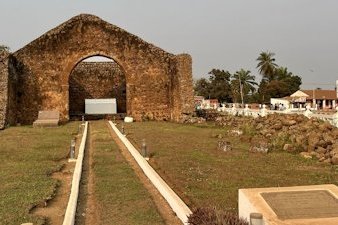Angola
Mbanza Kongo
Mbanza Kongo, Vestiges of the Capital of the former Kingdom of Kongo, represents the political and religious centre of a vast African kingdom that was transformed by the arrival of the Portuguese in the late 15th century.
The site (now a town of some 175,000 inhabitants) is located on a plateau. It comprises both archaeological remains of the precolonial period as well as colonial structures – often overlapping each other. The Kingdom of Kongo has strong intangible links with the slave trade and the early conversion of African kings to the Catholic religion (with a Cathedral and Jesuit College in place from the early 17th century).
Community Perspective: this site has been unreviewed so far.
Site Info
Official Information
- Full Name
- Mbanza Kongo, vestiges of the capital of the former Kingdom of Kongo (ID: 1511)
- Country
- Angola
- Status
-
Inscribed 2017
Site history
History of Mbanza Kongo
- 2017: Inscribed
- Inscribed
- 2016: Incomplete - not examined
- Type
- Cultural
- Criteria
- iii
- iv
Links
- UNESCO
- whc.unesco.org
- Related
-
- mbanzakongo.com — Extensive website by an archaeologist about oral traditions
All Links
UNESCO.org
- whc.unesco.org — whc.unesco.org/
Related Resources
- mbanzakongo.com — Extensive website by an archaeologist about oral traditions
News Article
- July 9, 2018 allafrica.com — France Promises More Support to Mbanza Kongo World Heritage Site
Community Information
- Community Category
- Archaeological site: Civilizations of Sub-Saharan Africa
Travel Information
One thousand visitors or fewer
Most Remote Cultural WHS
Recent Connections
-
Bantu peoples
.
-
Untranslated Toponyms
The word Mbanza comes from the Kongo Ba… -
One thousand visitors or fewer
“The current number of visitors, most o…
Connections of Mbanza Kongo
- Geography
-
-
Congo River Basin
On the Mepoza (M'pozo) river, which ends ends on the left bank of the Congo River
-
- Trivia
-
-
Built or owned by Portuguese
colonial period buildings
-
- History
-
-
African Kingdoms
Kingdom of Kongo (1390 - 1914)See en.wikipedia.org
-
Located in a Former Capital
Kingdom of Kongo -
Bantu peoples
.
-
- Architecture
-
-
Vernacular architecture
: Some dwellings conserve the characteristic traits of the typical 19th-20th century Kongo house (Nzo). Built on rubble foundations, with earthen or brick walls (the brick may be sun-dried or fired); they are long houses with two main rooms under a pitched roof (originally covered with straw). Colonial elements were added (verandas, pillars), and later industrial elements (corrugated metal sheet) replaced the local materials. (AB ev)
-
- Damaged
-
-
Destroyed during invasion
by the Portuguese in 1665
-
- World Heritage Process
-
-
First inscriptions
Angola (2017) -
Only WHS in their country
Angola -
Slow Starters
Angola 1991-2017 : 26 years
-
- Religion and Belief
-
-
Sacred Forests or Groves
Precinct of the Sacred Tree (Yala Nkuwu), in whose shade the sovereigns delivered justice. -
Franciscan Order
Franciscan sisters’ complex (school, convent and Church of St. Anthony, built from 1933 onwards). -
Jesuit Order
The main archaeological site, Tadi dya Bukikwa (“inverted stone” or “that which has not yet revealed its contents” in the Kikongo language), corresponds in all probability to the Jesuit college (AB ev) -
Cathedrals
Kulumbimbi is the Cathedral of the Holy Saviour, the first episcopal seat in Africa south of the Equator, and it forms the heart of the identity of the Kingdom of Kongo (AB ev) -
Legends and Folk Myths
Wiki: a popular legend that began in the 1680s that the king had buried his mother alive because she was not willing to give up an "idol" which she wore around her neck
-
- Human Activity
-
-
Slavery
However, relations between the Kingdom and the Portuguese went sour as a result of the slave trade. Several texts were enacted by sovereigns from the early 16th century onwards to prevent the rise of the slave trade, which was robbing the territory of its vital forces, and condemning it to decline. It has been estimated that between 1600 and 1852, 3 million slaves were transported to Brazil alone from the coasts of Kongo-Angola that is an average of 12,000 slaves per year. it is not even known whether slaves were brought to Mbanza Kongo or whether they were collected elsewhere in the Kingdom. (AB ev)
-
- Timeline
-
-
Built in the 13th century
Believed to have been founded in the 13th century (AB ev)
-
- Visiting conditions
-
-
One thousand visitors or fewer
“The current number of visitors, most of whom are local or regional, is low (508 in 2010 at the Museum of the Kings of Kongo, 892 in 2014). (AB ev) -
Most Remote Cultural WHS
6 hours by car from Luanda
-
- WHS Names
-
-
Untranslated Toponyms
The word Mbanza comes from the Kongo Bantu language and means "city" or "town". It was used to name the main urban centers of the Kingdom of Kongo (as also in as in M'banza-Soyo and Mbanza Ngungu) It was also used to refer to the "royal residence" or "palace" of the king.
-
News
- allafrica.com 07/09/2018
- France Promises More Support to Mb…
Recent Visitors
Community Reviews
No reviews yet. If you have visited, write one!
